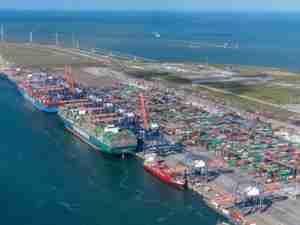ICTSI Laguna dry port expands facilities
posted by AJOT | May 19 2015 at 03:48 PM | Ports & Terminals
International Container Terminal Services, Inc.’s (ICTSI) dry port unit, Laguna Gateway Inland Container Terminal (LGICT), recently broke ground to start the expansion of new facilities which include extended and dedicated storage areas for loaded and empty containers, a runway for rubber tired gantries (RTG), container care facilities, weigh bridges at the gates and an upgraded access road, as it primes the Laguna dry port for the revival of intermodal freight transport in the Philippines.
The expansion works, which is Phase 1 development of LGICT, commenced after groundbreaking and time capsule lowering ceremonies attended by officers and staff of ICTSI and LGICT, representatives from joint venture partners Transnational Diversified Group and Nippon Container Terminals Co. Ltd., and officials from local government units at the Laguna dry port site in Calamba City, 58 kilometers south of Metro Manila, province of Laguna.
In his message, Christian R. Gonzalez, ICTSI Vice President and Head of Asia Pacific region, thanked partners, clients, the provincial government of Laguna, the city government of Calamba and all the parties involved in the Laguna dry port. He bared plans to revive an existing railroad connection that will directly link LGICT and ICTSI’s flagship Manila International Container Terminal (MICT), the country’s largest and sole dedicated container handling facility.
“It is a great aspiration that we have, not only to see this develop as an inland container terminal in today’s form, but also as an inland container terminal connected by rail to the country’s premier port in its future form. I think this ambition that we have is something that requires congratulations at this point. Obviously, with all the hard work from all of us and help of the government, we will make this a reality in the coming years,” says Mr. Gonzalez.
ICTSI was the first logistics company to introduce intermodal freight transport in the Philippines when it offered container transport service by rail from the late 1990s to the early 2000s. ICTSI divested from the business in 2003 due to a slowdown in the container market in southern Luzon. The improving Philippine economy in recent years resulted in increased container traffic, prompting ICTSI to re-open the Laguna dry port in March to support the growing volume. ICTSI also plans to revive the rail freight service to and from the MICT and the Laguna dry port in the near future.
“Once everybody starts using LGICT, we can expect even better productivity levels at MICT. Most importantly, the whole economy will benefit from this project,” Mr. Gonzalez adds. The dry port’s current annual capacity of 250,000 TEUs effectively increases MICT’s capacity by 10 percent. LGICT will help lower MICT’s import inventory, average import dwell time and laden yard utilization by offering storage services to clients in southern Luzon.
As a regional logistics hub, LGICT will provide the much-needed logistical support to manufacturers, importers and exporters at the economic zones within the CALABARZON area by reducing truck turnaround time and accelerating trade movement. It offers both short-term and long-term storage options as well as transport service to and from MICT.
Aside from its own transport service, LGICT has also contracted certified truck companies to provide a reliable trucking service alternative in the local logistics market. This initiative, as well as the completion of the rail linkage between MICT and LGICT, will result in seamless cargo transfer to the economic zones within Metro Manila and southern Luzon.
Initially, the newly opened Laguna dry port has four hectares of container yard operational and uses reach stackers in the hauling of containers. Phase 1 civil works, which is estimated to cost PHP 587 million, is eyed for completion by yearend. It will add a fully developed 7.22 hectares of concrete pavement, an RTG runway, dedicated stacking areas for loaded and empty containers, a container cleaning and repair area, access road, weigh bridges, a guardhouse and entry/exit barriers.
On full development, the dry port will have an area of 21 hectares and will include facilities for reefer containers, truck holding areas, a fuel station, a rail workshop and container freight stations. For its equipment fleet, on order are RTGs, side lifters, prime mover trucks and additional reach stackers.











